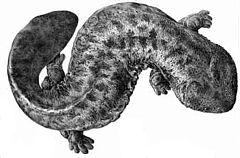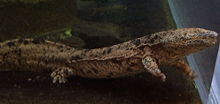- Japanese giant salamander
-
Japanese giant salamander 
Conservation status Scientific classification Kingdom: Animalia Phylum: Chordata Class: Amphibia Order: Caudata Family: Cryptobranchidae Genus: Andrias Species: A. japonicus Binomial name Andrias japonicus
(Temminck, 1837)Synonyms Megalobatrachus japonicus (Reviewed by Sato 1943)[1]
The Japanese giant salamander (Andrias japonicus) is endemic to Japan, where it is known as Ōsanshōuo (オオサンショウウオ/大山椒魚), literally meaning "giant pepper fish". With a length of up to almost 1.5 meters (5 ft),[2] it is the second largest salamander in the world, only being surpassed by the very similar and closely related Chinese giant salamander (A. davidianus).
Contents
Behavior
The Japanese giant salamander, being restricted to streams with clear cool water, is entirely aquatic and nocturnal. Unlike other salamanders who lose their gills early in their life cycle, they only breach their heads above the surface to obtain air without venturing out of the water and onto land. Also due to their large size and lack of gills, they are confined to flowing water where oxygen is abundant.[3] When threatened, these salamanders can excrete a strong-smelling milky substance whose odor resembles that of Japanese pepper (hence its name, giant pepper fish). It has very poor eyesight, and possesses special sensory cells covering its skin, running from head to toe and termed the lateral line system. These sensory cells host hair-like shapes that detect minute vibrations in the environment, and are quite similar to the hair cells of the human inner ear. This feature is essential for its hunting because of its poor eyesight. It feeds mainly on insects, frogs and fish. It has a very slow metabolism and lacks natural competitors. It is a long-lived species, with the captive record being an individual that lived in the Natura Artis Magistra, the Netherlands, for 52 years.[2] In the wild they may live for nearly 80 years.
History
The Japanese giant salamander was first catalogued by Europeans when the resident physician of Dejima island in Nagasaki, Philipp Franz von Siebold captured an individual and shipped it back to Leiden in the Netherlands, in the 1820s. The species was designated as a special natural monument in 1951 and has been protected. [4] It is a survivor from the Upper Jurassic period, some 140 million years ago.
Status
The Japanese giant salamander is threatened by pollution, habitat loss (among other changes, by the silting up of the rivers where it lives), and over-collecting. It is considered near threatened by IUCN, and is included on CITES Appendix I.[5] It can be found on the islands of Kyushu, Honshu and Shikoku in Japan. In the past they were fished out of rivers and streams as a source of food, but hunting has ceased because of protection acts.
Life cycle
The life cycle is similar to that of an amphibious salamander except it does not terrestrialize and remains underwater during adulthood. Specifically the Japanese giant salamander travels up stream into the mountains to spawn and lay eggs. Larvae emerge from the eggs and lose their gills when they become adults.
Reproduction
Hynobiid salamanders practice external fertilization, or spawning. And, unlike other salamander families which reproduce internally, male hynobiids focus on egg sacs rather than females during breeding (Hasumi, 2002). The female lays two egg sacs at a time, each containing up to seventy eggs. Parental care is common.[1] alternatively See Asiatic Salamander.
Cultural references
 Ukiyo-e print by Utagawa Kuniyoshi depicting a giant salamander being stabbed by the samurai Hanagami Danjō no jō Arakage.
Ukiyo-e print by Utagawa Kuniyoshi depicting a giant salamander being stabbed by the samurai Hanagami Danjō no jō Arakage.
The Japanese giant salamander has been the subject of legend and artwork in Japan, for example in the ukiyo-e work by Utagawa Kuniyoshi.
See also
- List of Special Places of Scenic Beauty, Special Historic Sites and Special Natural Monuments
References
- ^ "Amphibian Species of the World - Andrias japonicus (Temminck, 1836)". Research.amnh.org. http://research.amnh.org/herpetology/amphibia/references.php?id=27701. Retrieved 2010-02-04.
- ^ a b Andrias japonicus - Amphibiaweb
- ^ The Encyclopedia of Reptiles and Amphibians. Facts on File Inc.. 1986. ISBN 0-8160-1359-4.
- ^ "オオサンショウウオ". The Agency for Cultural Affairs. http://www.bunka.go.jp/bsys/maindetails.asp?register_id=401&item_id=3129. Retrieved 2011-09-24.(Japanese)
- ^ Japanese giant salamander. ARKive. Retrieved 2008-09-19.
External links
 Media related to Andrias japonicus at Wikimedia CommonsCategories:
Media related to Andrias japonicus at Wikimedia CommonsCategories:- IUCN Red List near threatened species
- Cryptobranchidae
- Special Natural monuments of Japan
- Amphibians of Japan
- Megafauna of Eurasia
- Animals described in 1837
Wikimedia Foundation. 2010.


